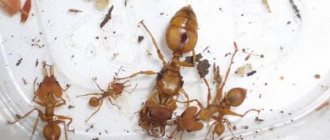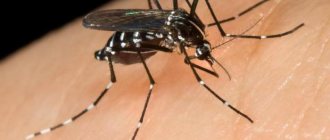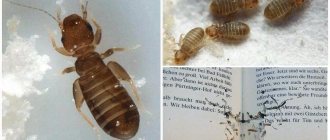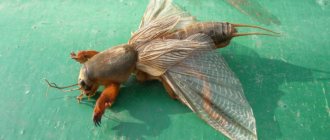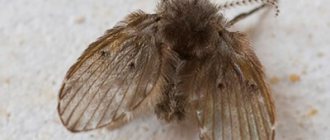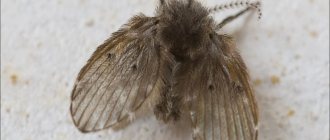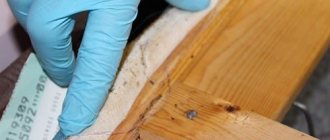The silverfish (Lepisma saccharina) is a wingless arthropod insect from the bristletail order, whose ancestors existed millions of years ago. The common silverfish is also called the sugar silverfish and silverfish because of its silvery-metallic color. And translated from English, silverfish are called “silver fish.”
Silverfish prefer to live in dark and damp rooms - a bathroom, bathhouse, basement, attic or garage. These insects tend to hide from people, so the apartment dweller may not immediately understand that there are “living creatures” in his bathroom.
Description of the appearance of silverfish
The silverfish has no wings, but can run very fast. Adult silverfish have a body length of about 12-19 mm, not including the tail. They have a flat, teardrop-shaped body that tapers from the head to the back and is usually covered in scales. There are three long processes on the tail. They also have thread-like antennae and small, wide-set eyes.
Immature silverfish are similar to adults except for size and color (they are smaller and white), and their scales appear during their third or fourth molt.
Home thermobia
In total, there are about 600 species of silverfish in the world, and only 10 of them can be found in the vastness of our country. Common silverfish and domestic thermobia often penetrate into apartments (photo below).
Common silverfish and house thermobia
On a note!
House thermobia is a smaller insect, the length of which does not exceed 12 mm. A characteristic feature of an individual of this species is the brown color of the body.
Features and lifestyle
Silverfish move quickly and climb vertical surfaces well. They can live for several weeks without food or water, but they require high humidity of 70 to 90 percent to live comfortably. Silverfish prefers places with room temperature (21-29 degrees C). They are nocturnal and prefer to hide or rest in narrow cracks or crevices during the day. Silverstone can be found almost anywhere in the home, including living rooms, bedrooms, bathrooms, attics, basements and garages.
Silverfish thrive in shops, libraries and offices. They often enter commercial premises through cardboard boxes containing books and papers from contaminated areas. They will travel quite a distance in search of food, but once they find a suitable food source, they will stay close to it. Indoors, they can breed in a variety of areas including wall voids, inside/under subfloors, attics, etc.
Danger and harm to humans
Silverfish have a weak mouthparts, because... They feed on soft, rotten organic matter, so they are unable to bite through human skin. At the same time, if such an insect crawls around the bathroom, it can cause an attack of fear and other unpleasant sensations.
Silverfish are not capable of biting humans, but are carriers of the fungus.
In addition, silverfish can act as carriers of fungus and pathogenic bacteria. They can harm indoor plants and spoil vegetables stored in the kitchen or on the balcony.
Reproduction and lifespan
Before mating, the silverfish performs love dances. Males lay spermatophores, which take females into the ovipositor. The number of eggs and the habits of females vary depending on the species. The female sugar silverfish lays from one to three eggs per day (and the domestic thermobia can lay up to 40 eggs per day), placing them in cracks, under objects or leaving them unprotected in open space.
The development time of the larvae is three to four months under favorable conditions: 20–30 degrees and a relative humidity of at least 50–75 percent. Otherwise, it may take up to two to three years. Most silverfish live up to three years.
Newly hatched young silverfish, also known as nymphs, have a white body color. Nymphs emerge fully formed from the egg and undergo a series of moults to become full-fledged adults. As they age, the nymphs darken and acquire a silvery-brownish color.
A silverfish can produce more than 50 moults in its life, so in a room infested with these insects, fragments of their scales will certainly be found.
Finding even one nymph in your home can be a cause for concern. Regardless of age, the presence of one silverfish usually indicates that a full-scale infestation has already occurred in hidden areas of your home.
Fighting methods
To get rid of silverfish, you can use various folk and chemical remedies. In addition, it is recommended to use the services of professionals. After eliminating silverworms, you need to make sure that they do not appear again.
Physical methods
There are different ways to combat silverfish.
To prevent silverfish from living in the bathroom, it is necessary to reduce the humidity. You should carefully inspect the pipes to identify leaks and repair them.
All rooms where insects were previously identified should be thoroughly cleaned and treated with bleach. After the walls and floors have dried, they must be coated with a solution of copper sulfate. This will destroy the silverfish eggs. You should open the bathroom so that the air in it becomes drier. It is advisable to install a forced ventilation system.
All rugs, towels and other things that were in the bathroom must be washed and dried in the sun. It is recommended to throw away items that are very damp.
Traps and bait
The favorite place of silverfish is wet birch brooms.
Traps and baits are odorless. They are convenient to use in cases where there is a possibility of adult silverfish entering from the basement or attic. You can make traps yourself. These insects love to hide in wet birch brooms. They should be placed in the bathroom at night. In the morning, the brooms should be thrown away.
In addition, traps made of glass jars help against these insects. Pour 2-3 drops of honey into the container. The outer surface of the jar is covered with paper. Insects will easily climb into the container, but will not be able to get out. You can use paper as a trap. It should be rolled into a roll that is not too tight and wet. The trap is placed under the bathtub at night. It needs to be thrown away in the morning.
Chemicals
There are many chemical preparations in the form of powders, sprays and gels that can quickly remove silverfish, cockroaches, fleas and other insects. You can use Raid, Combat, Dichlorvos Varan. These products are available in the form of an odorless spray. After using such drugs, be sure to ventilate the room.
The insecticide Tarax helps get rid of silverfish quickly . It is also effective against woodlice, centipedes, bedbugs and other insects.
Gel-form preparations often used to eliminate these creatures include Antiinsect. This remedy is harmless to humans, like the drugs Gettor and Clean House.
Folk remedies
Red pepper and tobacco help to quickly remove silverfish. To prepare the composition you need to mix 5 tsp. soda, 1 tsp. tobacco and 1 tsp. ground red pepper. The mixture must be diluted with 1 liter of warm water. The resulting product is used to treat the walls and floor of the bathroom. After this, you need to rinse the surfaces with water and bleach and ventilate the room well.
You can fight these insects with boric acid. The product is sold in powder form. Up to 25 g of this substance dissolves in 1 liter of warm water. The resulting mixture is used to treat areas under the bathtub and sink. The room is ventilated after the procedure.
You can use salt to repel silverfish. It is scattered in paths under the baseboards in the bathroom and toilet.
Boric acid to combat silverfish.
In addition, it is recommended to regularly wash floors, walls, furniture and bathroom fixtures with water containing citrus and lavender essential oils. This helps repel silverfish.
Signs of silverfish
You can find silverfish in a bathroom or other damp room by turning on the light at night. The insects will immediately try to hide. In this they are similar to cockroaches.
If no live specimens are visible, but there are yellow spots, silvery scales, or tiny feces that look like fine black pepper, this indicates that silverfish have already taken up residence in your home.
Silverfish can easily climb walls and find entry around window and door frames, utility pipes and vents, foundation cracks, and holes in mosquito nets. Therefore, the insect could get into your apartment from neighbors, from the basement or from the street.
Why do they appear?
Most people are quite confident that their home is clean and safe enough to live in. In practice, it turns out that the level of sanitation and hygiene in the home is not very high. The causes of pests are:
- violations of thermoregulation and humidity levels in residential premises;
- lack of regular ventilation;
- free access to water and food waste;
- violation of rules for storing books and printed publications.
“Silverfish in the apartment - how to get rid of it?” — queries of this kind regularly appear on the Internet, but the answers to them should be sought in the root causes of the appearance of the insect. If there are cracks in the premises through which insects can get inside, and dark and damp areas of the floor and walls under the bathroom, behind pipes, under baseboards are not wiped dry regularly, you should expect from the very beginning that the situation will get out of control. Pests can also appear in the company of other parasites, much more dangerous than the small silverfish.
What harm do silverfish cause? Are they dangerous?
Silverfish do not bite humans, drink blood, or spread disease. But they can harm personal belongings, especially those made of paper. Sugarfish are known to infest items such as wallpaper, books, magazines and envelopes, so these materials can become damaged over time as a result of a silverfish infestation. They can also feed on glue and clothing, as well as foods such as oatmeal and flour.
Agree, it is unpleasant to find an insect in food or on your favorite books. Silverfish, like moths, can chew your clothes and upholstery.
In addition to material damage, silverfish can cause allergies in humans.
Silverfish also do not pose any harm to domestic animals; even if accidentally swallowed, they are not poisonous.
Folk remedies
The first effective method is food and spices with a pronounced smell: bay leaves, cinnamon and sage are suitable. They can be used dried or you can buy essential oils. In dried form: place open packages around the area of the room, place more packages in secluded places. Citrus essential oils are also suitable: orange, lemon, grapefruit or plants such as eucalyptus. However, you need to be careful with essential oils: the strong smell can cause headaches in households. People prone to allergic reactions should not conduct such experiments. Another option is orthoboric acid. It can be consumed in dry form by mixing the powder with chalk in a ratio of 4:1, respectively. The resulting mixture is scattered in various corners of the bathroom. You can prepare an aqueous solution. To do this, take a teaspoon of acid and add it to 0.5 liters of water. The prepared liquid is poured into lids. Lids with liquid are placed around the area of the room. Please note: it is not recommended to use orthoboric acid if there are pets and children living in the house! Diatomaceous earth, food powder, is also used in the fight against insects. The main advantage is complete safety and environmental friendliness. Can be used undiluted or in a mixture of ready-made products, for example Ecokiller. It is recommended to sprinkle the powder before going to bed, do not forget to wear a mask, otherwise grains of sand with sharp ends may cause irritation of the mucous membrane if they get into the throat.
As a folk remedy, many use sawdust, for example, from cedar. But they cannot be used in visible places; they are dusty and easily clog the house. Place them in secluded parts of the room. Sawdust must be changed every seven days.
Preventing the appearance of silverfish
To prevent the appearance of silverfish in a house or apartment, you should monitor the humidity and try to dry the air in especially damp rooms. For example, it is better to leave the bathroom door open after a shower so that it can ventilate. If you live in a damp climate, you will have to purchase a dehumidifier and use an air conditioner or heater more often.
Repair leaking pipes and drains and remove or replace any moldy or damp wood in your home. Avoid storing old books and magazines in areas where silverfish are commonly found, such as basements, attics and garages. And it's important to store foods like flour and sugar in airtight containers.
To prevent silverfish from coming into your private home from the street, be sure to remove piles of fallen leaves, do not store firewood and building materials on the ground, remove vegetation along the foundation, and seal all cracks and crevices in the walls and foundation.
If there is a large presence of silverfish in your home, it is best to call a licensed pest control professional to thoroughly inspect your home and recommend the appropriate pest control method.
If there are not too many silverfish yet, you can breed them yourself.
How to get rid of silverfish in the bathroom and toilet: chemicals
If preventative measures do not help, and the insect makes its way into the bathroom and toilet, there are chemical means of control. But you can’t just take an aerosol and spray and get the silverfish out of the bathroom! Why?
Not all substances are effective against insects - even if indicated on the packaging, according to reviews, the product is often ineffective.
- Almost all aerosols and sprays are contact preparations: a “point” effect or treatment of habitats is necessary.
- It is unlikely to “spray” silverfish precisely; finding its abode is difficult. All that remains is to treat areas in the bathroom and toilet in the hope that one day she will walk through them.
- Many poisons (dusts and others) lose their effectiveness when exposed to a humid environment. Many, especially those used in bait traps, will not be eaten by insects, which are not attracted to the caked dust.
What to do? Look for ways to get rid of silverfish that work! Of the common ones that are recognized as the best and quite effective:
- Insecticides based on pyrethrin and peritroids (bifenthrin, tetramethrin, cyfluthrin, phenthothrin).
- According to scientists at the University of Minnesota, USA, products based on permethrin, deltamethrin, cyfluthrin, and cypermethrin - Demon Wp, for example, are effective against silverfish.
- Good old boric acid: cheap and not cheerful. It is capable, if not of expelling all silverfish from the toilet and in the bathroom, then of reducing the population. But only for common silverfish: boric acid is not effective against thermobia.
- It is worth choosing drugs based on silica gel, kieselguhr, which destroy the gastrointestinal tract and lead to death.
- Diatomite is a remedy for silverfish and more. It crumbles in places of dislocation, then is removed (you can simply vacuum it).
- Naphthalene is an old and universal remedy that also works against silverfish in the toilet. By spreading out the bags, you can get rid of the infestation, but be careful: naphthalene vapors are poisonous.
- Pyrethrin-based aerosols are an effective remedy, but it is important to spray them away from pets, children, and food. They treat wet areas with accumulation of condensation and places where insects accumulate, sewer and water pipes, joints, surfaces with cracks, etc.
Strange white creatures in the apartment
It would seem strange to see extra living creatures in the bathroom, since this part should always be clean, but for some, a large amount of water and a comfortable temperature play a major role.
White is a characteristic color for silverfish that have just molted. Usually these insects are up to 1 cm, they have an elongated body, silver or almost transparent color. Very be moving around.
Another species is woodlice. Not dangerous to human life and health.
Let's celebrate! Basically, these two species settle in the walls of the bathtub, since all the conditions for a comfortable life are provided for them. Unlike Prussians and other pests, they are not dangerous, do not carry disease, and do not bite.
Small white insects
This description characterizes woodlice. Such an inhabitant is not uncommon and can often be found in the vicinity of the bath. They have a light body, oblong shape with small scales. Woodlice move very quickly, so they are often very difficult to catch and even see.
Long white insects
Silverfish have a long white body. The main difference from other insects is the presence of a large number of legs on both sides.
Most are silver-black, some are brown. The main food for these insects is glue. In addition to typical inhabitants, the bathroom can be subject to attacks by cockroaches, midges and ants.
Description of the pest
Name: Common or sugar silverfish Lat.:
Lepisma saccharinaClass: Insects - Insecta Order: Bristletails - Zygentoma Family: Silverfish - Lepismatidae
| Habitats: | wet parts of the house |
| Dangerous for: | products, paper, interior items |
| Means of destruction: | traps, unpleasant odors, chemicals |
There are about 190 species of silverfish. About 10 species live in temperate latitudes. The insect resembles a flycatcher, although the latter have longer legs. Many scientists believe that the homeland of insects is the tropics.
Ideal conditions for reproduction are considered to be a humidity of at least 75% and a temperature of 21 to 26 degrees Celsius. In front of the silverfish there is a pair of long whiskers. The posterior part is characterized by three tail filaments. Insects don't have wings. They are nocturnal.
Pests are afraid of bright lighting. When exposed to light, they seek shelter. They move in quick dashes, sometimes making short pauses. When the temperature drops below 5 degrees Celsius, they go into suspended animation. At temperatures of 10 degrees below zero, larvae and adults die.



